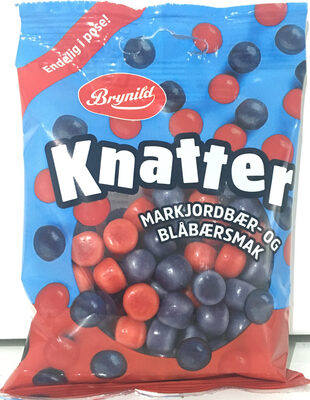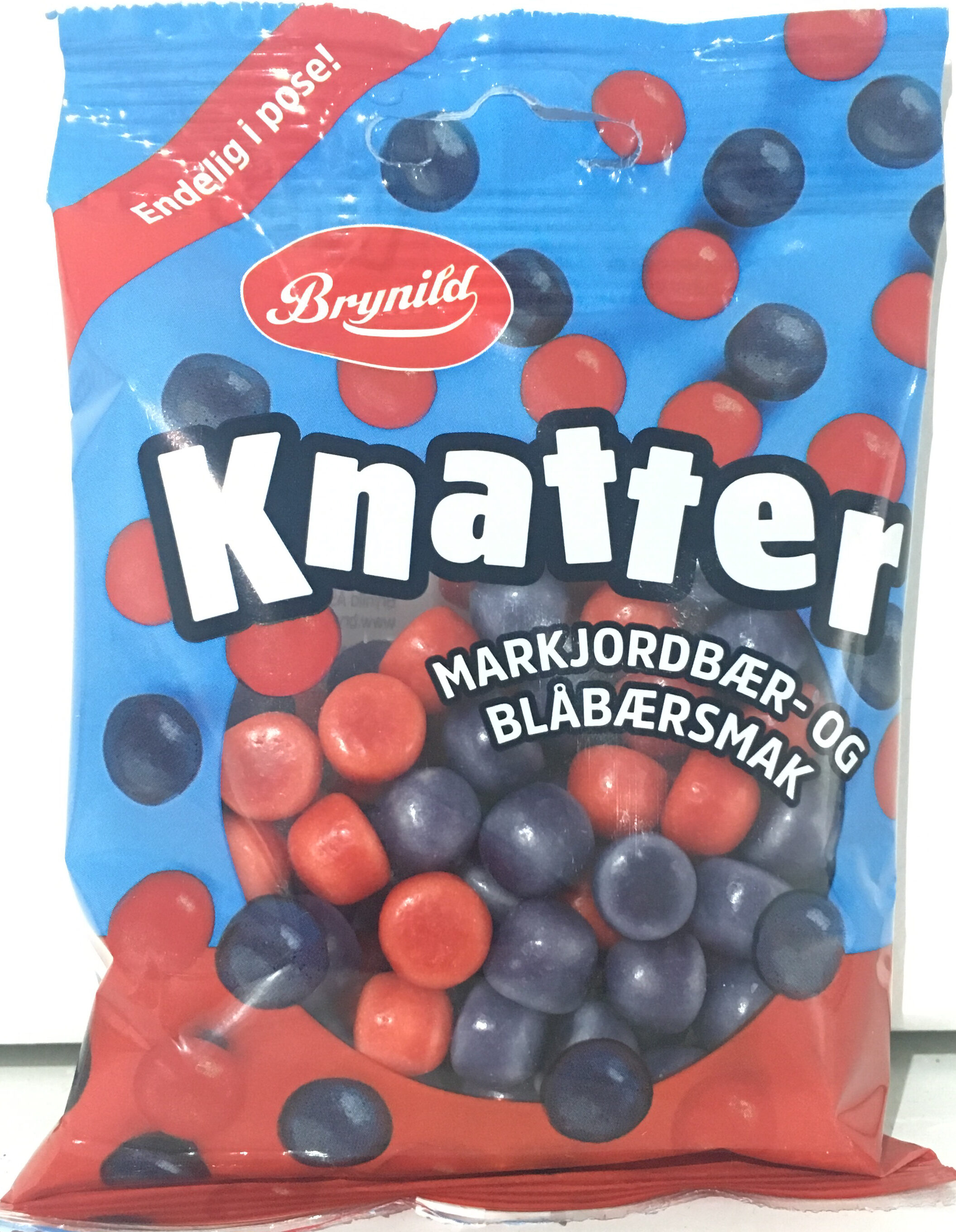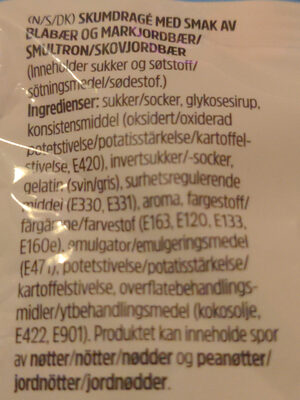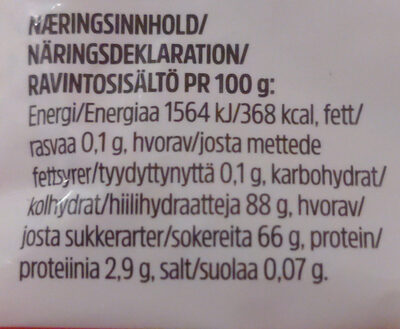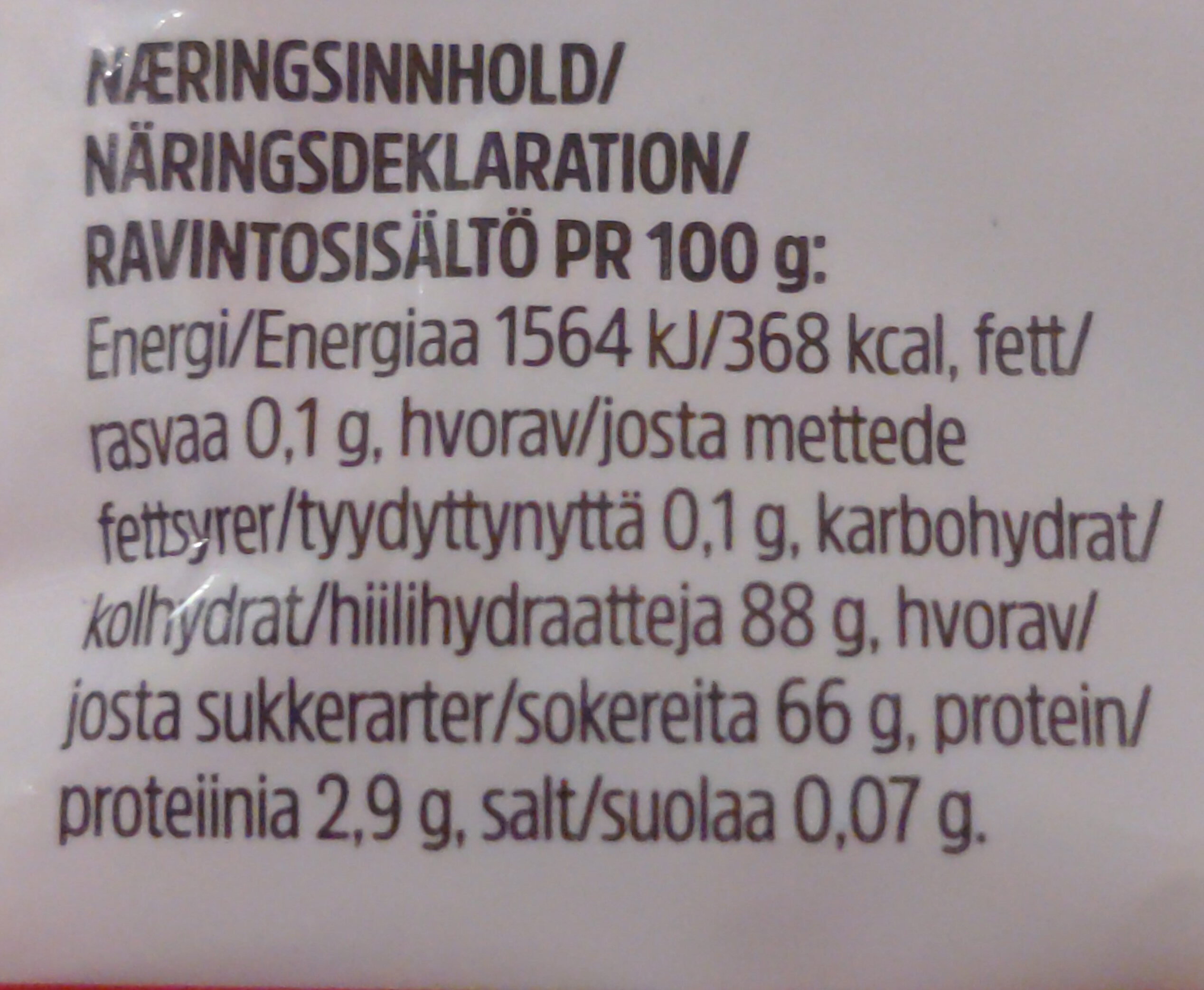Hjelp oss med å gjøre åpenhet om mat til det normale!
Som en ideell organisasjon, er vi avhengige av dine donasjoner for å fortsette å informere forbrukere verden over om hva de spiser.
Matrevolusjonen starter med deg!
Knatter - Brynild - 80 g
Knatter - Brynild - 80 g
Denne produktsiden er ikke fullstendig. Du kan hjelpe med å ferdigstille den ved å redigere den og legge til mere data fra bildene vi har, eller ved å ta flere bilder i appen for Android eller iPhone/iPad. Takk!
×
Strekkode: 7041111138438 (EAN / EAN-13)
Mengde: 80 g
Emballasje: en:Plastic
Merker: Brynild
Kategorier: en:Snacks, en:Sweet snacks, en:Confectioneries, en:Dragées
Etiketter, sertifiseringer, priser:
Grønt Punkt
Produksjon- eller behandlingssteder: Norway
Lenke til produktsiden på den offisielle nettsiden til produsenten: http://www.brynildgruppen.no
Land hvor produktet selges: Norge
Samsvarer med dine preferanser
Helse
Ingredienser
-
23 ingredienser
: sukker, glukosesirup, stivelse, E420), invertsukker, gelatin: (svin), surhetsregulerende middel (E330, E331), aroma, fargestoff (E163, E120, E133, E160e) emulgator (E471), potetstivelse, overflatebehandlingsmidler (kokosolje, E422, E901). Produktet kan inneholde spor av nøtter og peanøtter.Allergener: no:nøtter, no:peanøtterSpor: en:Gelatin, Nøtter, Peanøtt
Matprosessering
-
Ultrabearbeidede matvarer
Elementer som indikerer at produkter er i en:4 - Ultra processed food and drink products-gruppen:
- Tilsetningsstoff: E120 - Karmin
- Tilsetningsstoff: E133 - Briljantblà FCF
- Tilsetningsstoff: E163 - Antocyaniner
- Tilsetningsstoff: E420 - Sorbitol
- Tilsetningsstoff: E422 - Glycerol
- Tilsetningsstoff: E428 - Gelatin
- Tilsetningsstoff: E471 - Mono- og diglyserider av fettsyrer
- Tilsetningsstoff: E901 - Bivoks
- Ingrediens: Aroma
Matvarer er inndelt i 4 grupper i henhold til bearbeidingsgraden:
- Ubearbeidet eller minimalt bearbeidet mat
- Bearbeidede kulinariske ingredienser
- Bearbeidet mat
- Ultrabearbeidede matvarer
Bestemmelsen av gruppa er basert på kategorien til produktet og på ingrediensene den inneholder.
Tilsetningsstoffer
-
E120 - Karmin
Carminic acid: Carminic acid -C22H20O13- is a red glucosidal hydroxyanthrapurin that occurs naturally in some scale insects, such as the cochineal, Armenian cochineal, and Polish cochineal. The insects produce the acid as a deterrent to predators. An aluminum salt of carminic acid is the coloring agent in carmine. Synonyms are C.I. 75470 and C.I. Natural Red 4. The chemical structure of carminic acid consists of a core anthraquinone structure linked to a glucose sugar unit. Carminic acid was first synthesized in the laboratory by organic chemists in 1991.Kilde: Wikipedia (Engelsk)
-
E133 - Briljantblà FCF
Brilliant Blue FCF: Brilliant Blue FCF -Blue 1- is an organic compound classified as a triarylmethane dye and a blue azo dye, reflecting its chemical structure. Known under various commercial names, it is a colorant for foods and other substances. It is denoted by E number E133 and has a color index of 42090. It has the appearance of a blue powder. It is soluble in water, and the solution has a maximum absorption at about 628 nanometers.Kilde: Wikipedia (Engelsk)
-
E163 - Antocyaniner
Anthocyanin: Anthocyanins -also anthocyans; from Greek: ἄνθος -anthos- "flower" and κυάνεος/κυανοῦς kyaneos/kyanous "dark blue"- are water-soluble vacuolar pigments that, depending on their pH, may appear red, purple, or blue. Food plants rich in anthocyanins include the blueberry, raspberry, black rice, and black soybean, among many others that are red, blue, purple, or black. Some of the colors of autumn leaves are derived from anthocyanins.Anthocyanins belong to a parent class of molecules called flavonoids synthesized via the phenylpropanoid pathway. They occur in all tissues of higher plants, including leaves, stems, roots, flowers, and fruits. Anthocyanins are derived from anthocyanidins by adding sugars. They are odorless and moderately astringent. Although approved to color foods and beverages in the European Union, anthocyanins are not approved for use as a food additive because they have not been verified as safe when used as food or supplement ingredients. There is no conclusive evidence anthocyanins have any effect on human biology or diseases.Kilde: Wikipedia (Engelsk)
-
E330 - Sitronsyre
Citric acid: Citric acid is a weak organic acid that has the chemical formula C6H8O7. It occurs naturally in citrus fruits. In biochemistry, it is an intermediate in the citric acid cycle, which occurs in the metabolism of all aerobic organisms. More than a million tons of citric acid are manufactured every year. It is used widely as an acidifier, as a flavoring and chelating agent.A citrate is a derivative of citric acid; that is, the salts, esters, and the polyatomic anion found in solution. An example of the former, a salt is trisodium citrate; an ester is triethyl citrate. When part of a salt, the formula of the citrate ion is written as C6H5O3−7 or C3H5O-COO-3−3.Kilde: Wikipedia (Engelsk)
-
E331 - Natriumsitrater
Sodium citrate: Sodium citrate may refer to any of the sodium salts of citrate -though most commonly the third-: Monosodium citrate Disodium citrate Trisodium citrateThe three forms of the salt are collectively known by the E number E331. Sodium citrates are used as acidity regulators in food and drinks, and also as emulsifiers for oils. They enable cheeses to melt without becoming greasy.Kilde: Wikipedia (Engelsk)
-
E420 - Sorbitol
Sorbitol: Sorbitol --, less commonly known as glucitol --, is a sugar alcohol with a sweet taste which the human body metabolizes slowly. It can be obtained by reduction of glucose, which changes the aldehyde group to a hydroxyl group. Most sorbitol is made from corn syrup, but it is also found in nature, for example in apples, pears, peaches, and prunes. It is converted to fructose by sorbitol-6-phosphate 2-dehydrogenase. Sorbitol is an isomer of mannitol, another sugar alcohol; the two differ only in the orientation of the hydroxyl group on carbon 2. While similar, the two sugar alcohols have very different sources in nature, melting points, and uses.Kilde: Wikipedia (Engelsk)
-
E422 - Glycerol
Glycerol: Glycerol -; also called glycerine or glycerin; see spelling differences- is a simple polyol compound. It is a colorless, odorless, viscous liquid that is sweet-tasting and non-toxic. The glycerol backbone is found in all lipids known as triglycerides. It is widely used in the food industry as a sweetener and humectant and in pharmaceutical formulations. Glycerol has three hydroxyl groups that are responsible for its solubility in water and its hygroscopic nature.Kilde: Wikipedia (Engelsk)
-
E471 - Mono- og diglyserider av fettsyrer
Mono- and diglycerides of fatty acids: Mono- and diglycerides of fatty acids -E471- refers to a food additive composed of diglycerides and monoglycerides which is used as an emulsifier. This mixture is also sometimes referred to as partial glycerides.Kilde: Wikipedia (Engelsk)
-
E901 - Bivoks
Beeswax: Beeswax -cera alba- is a natural wax produced by honey bees of the genus Apis. The wax is formed into "scales" by eight wax-producing glands in the abdominal segments of worker bees, which discard it in or at the hive. The hive workers collect and use it to form cells for honey storage and larval and pupal protection within the beehive. Chemically, beeswax consists mainly of esters of fatty acids and various long-chain alcohols. Beeswax has long-standing applications in human food and flavoring. For example, it is used as a glazing agent or as a light/heat source. It is edible, in the sense of having similar negligible toxicity to plant waxes, and is approved for food use in most countries and the European Union under the E number E901. However, the wax monoesters in beeswax are poorly hydrolysed in the guts of humans and other mammals, so they have insignificant nutritional value. Some birds, such as honeyguides, can digest beeswax. Beeswax is the main diet of wax moth larvae.Kilde: Wikipedia (Engelsk)
Analyse av ingredienser:
-
en:May contain palm oil
Ingredienser som kan inneholde palmeolje: E471
-
en:Non-vegan
Ikke-veganske ingredienser: E120, E901Noen ingredienser kunne ikke gjenkjennes.
Vi trenger din hjelp!
Du kan hjelpe oss med å gjenkjenne flere ingredienser og bedre analysere ingredienslista for dette produktet og andre ved å:
- Rediger denne produktsiden for å korrigere skrivefeil i ingredienslista, og/eller for å fjerne ingredienser på andre språk og setninger som ikke er knyttet til ingrediensene.
- Legg inn nye oppføringer, synonymer eller oversettelser til våre flerspråklige ingredienslister, ingrediensbearbeidingsmetoder, og etiketter.
Bli med i kanalen #ingredients på vårt Slack-samtalested og/eller lære om ingrediensanalyse på wikien vår, hvis du ønsker å hjelpe til. Tusen takk!
-
en:Non-vegetarian
Ikke-vegetarianske ingredienser: E120Noen ingredienser kunne ikke gjenkjennes.
Vi trenger din hjelp!
Du kan hjelpe oss med å gjenkjenne flere ingredienser og bedre analysere ingredienslista for dette produktet og andre ved å:
- Rediger denne produktsiden for å korrigere skrivefeil i ingredienslista, og/eller for å fjerne ingredienser på andre språk og setninger som ikke er knyttet til ingrediensene.
- Legg inn nye oppføringer, synonymer eller oversettelser til våre flerspråklige ingredienslister, ingrediensbearbeidingsmetoder, og etiketter.
Bli med i kanalen #ingredients på vårt Slack-samtalested og/eller lære om ingrediensanalyse på wikien vår, hvis du ønsker å hjelpe til. Tusen takk!
-
Detaljer fra analysen av ingrediensene
Vi trenger din hjelp!
Noen ingredienser kunne ikke gjenkjennes.
Vi trenger din hjelp!
Du kan hjelpe oss med å gjenkjenne flere ingredienser og bedre analysere ingredienslista for dette produktet og andre ved å:
- Rediger denne produktsiden for å korrigere skrivefeil i ingredienslista, og/eller for å fjerne ingredienser på andre språk og setninger som ikke er knyttet til ingrediensene.
- Legg inn nye oppføringer, synonymer eller oversettelser til våre flerspråklige ingredienslister, ingrediensbearbeidingsmetoder, og etiketter.
Bli med i kanalen #ingredients på vårt Slack-samtalested og/eller lære om ingrediensanalyse på wikien vår, hvis du ønsker å hjelpe til. Tusen takk!
: sukker, glukosesirup, stivelse, e420, invertsukker, gelatin (), surhetsregulerende middel (e330, e331), aroma, fargestoff (e163, e120, e133, e160e), emulgator (e471), potetstivelse, overflatebehandlingsmidler (kokosolje, e422, e901), Produktet kan inneholde spor av _nøtter_ og _peanøtter_- sukker -> en:sugar - vegan: yes - vegetarian: yes - ciqual_proxy_food_code: 31016 - percent_min: 7.69230769230769 - percent_max: 100
- glukosesirup -> no:glukosesirup - percent_min: 0 - percent_max: 50
- stivelse -> no:stivelse - percent_min: 0 - percent_max: 33.3333333333333
- e420 -> en:e420 - vegan: yes - vegetarian: yes - percent_min: 0 - percent_max: 25
- invertsukker -> no:invertsukker - percent_min: 0 - percent_max: 20
- gelatin -> no:gelatin - percent_min: 0 - percent_max: 0
- surhetsregulerende middel -> en:acidity-regulator - percent_min: 0 - percent_max: 0
- e330 -> en:e330 - vegan: yes - vegetarian: yes - percent_min: 0 - percent_max: 0
- e331 -> en:e331 - vegan: yes - vegetarian: yes - percent_min: 0 - percent_max: 0
- aroma -> en:flavouring - vegan: maybe - vegetarian: maybe - percent_min: 0 - percent_max: 0
- fargestoff -> no:fargestoff - percent_min: 0 - percent_max: 0
- e163 -> en:e163 - vegan: yes - vegetarian: yes - percent_min: 0 - percent_max: 0
- e120 -> en:e120 - vegan: no - vegetarian: no - percent_min: 0 - percent_max: 0
- e133 -> en:e133 - vegan: yes - vegetarian: yes - percent_min: 0 - percent_max: 0
- e160e -> en:e160e - vegan: yes - vegetarian: yes - percent_min: 0 - percent_max: 0
- emulgator -> no:emulgator - percent_min: 0 - percent_max: 0
- e471 -> en:e471 - vegan: maybe - vegetarian: maybe - from_palm_oil: maybe - percent_min: 0 - percent_max: 0
- potetstivelse -> no:potetstivelse - percent_min: 0 - percent_max: 0
- overflatebehandlingsmidler -> no:overflatebehandlingsmidler - percent_min: 0 - percent_max: 0
- kokosolje -> no:kokosolje - percent_min: 0 - percent_max: 0
- e422 -> en:e422 - vegan: maybe - vegetarian: maybe - percent_min: 0 - percent_max: 0
- e901 -> en:e901 - vegan: no - vegetarian: yes - percent_min: 0 - percent_max: 0
- Produktet kan inneholde spor av _nøtter_ og _peanøtter_ -> no:produktet-kan-inneholde-spor-av-nøtter-og-peanøtter - percent_min: 0 - percent_max: 0
Ernæring
-
Svak ernæringskvalitet
⚠ ️Advarsel: mengden frukt, grønnsaker og nøtter er ikke spesifisert på etiketten, den ble anslått utfra ingredienslista: 0Dette produktet regnes ikke som en drikke under beregningen av Nutri-Score.
Positive poeng: 0
- Protein: 1 / 5 (verdi: 2.9, avrundet verdi: 2.9)
- Fiber: 0 / 5 (verdi: 0, avrundet verdi: 0)
- Frukt, grønnsaker, nøtter, og raps/valnøtt/olivenoljer: 0 / 5 (verdi: 0, avrundet verdi: 0)
Negative poeng: 14
- Energi: 4 / 10 (verdi: 1564, avrundet verdi: 1564)
- Sukker: 10 / 10 (verdi: 66, avrundet verdi: 66)
- Mettet fett: 0 / 10 (verdi: 0.1, avrundet verdi: 0.1)
- Natrium: 0 / 10 (verdi: 28, avrundet verdi: 28)
Poengene for proteiner telles ikke fordi de negative poengene er større eller lik 11.
Ernæringsverdi: (14 - 0)
Nutri-Score:
-
Næringsnivåer
-
Fett i liten kvantitet (0.1%)
Fint å vite- Et høyt inntak av fett, spesielt mettet fett, kan øke kolesterolet, som øker risikoen for hjertesjukdommer.
Anbefaling: Reduser inntaket av fett og mettet fett- Velg produkter med lavere fett- og mettet fettinnhold.
-
Mettet fett i liten kvantitet (0.1%)
Fint å vite- Et høyt inntak av fett, spesielt mettet fett, kan øke kolesterolet, som øker risikoen for hjertesjukdommer.
Anbefaling: Reduser inntaket av fett og mettet fett- Velg produkter med lavere fett- og mettet fettinnhold.
-
Sukkerarter i høy kvantitet (66%)
Fint å vite- Et høyt inntak av sukker kan føre til økning i vekt og tannråte. Det øker også risikoen for diabetes type 2 og hjerte- og karsjukdommer.
Anbefaling: Begrens inntaket av sukker og sukkerholdige drikker- Sukkerholdige drikker (som brus, fruktdrikker, og fruktjuicer og nektar) burde begrenses så mye som mulig (ikke mer enn 1 glass om dagen).
- Velg produkter med lavt sukkerinnhold og reduser inntaket av produkter med tilsatt sukker.
-
Salt i liten kvantitet (0.07%)
Fint å vite- Et høyt inntak av salt (eller sodium) kan føre til et økt blodtrykk, som kan føre til høyere risiko for hjertesjukdom og slag.
- Mange folk har høyt blodtrykk uten å vite det, siden det ofte ikke er noen symptomer.
- De fleste inntar for mye salt (i gjennomsnitt 9 til 12 gram per dag), cirka det dobbelte av den anbefalte høyeste mengden av inntak.
Anbefaling: Begrens inntaket av salt og saltet mat- Reduser mengden salt som brukes ved matlaging, og ikke salt igjen ved bordet.
- Begrens inntaket av salte snacks og velg produkter med lavere saltinnhold.
-
-
Ernæringsinnhold
Ernæringsinnhold Som solgt
for 100 g / 100 mlSammenlignet med: en:Confectioneries Energi 1 564 kj
(368 kcal)−8 % Fett 0,1 g −99 % Mettet fett 0,1 g −98 % Karbohydrat 88 g +28 % Sukkerarter 66 g +28 % Kostfiber - Protein 2,9 g −29 % Salt 0,07 g −63 % Fruits‚ vegetables‚ nuts and rapeseed‚ walnut and olive oils (estimate from ingredients list analysis) 0 %
Miljø
-
Eco-Score C - Moderat miljøavtrykk
Eco-Scoren er en eksperimentell poengsum som oppsummerer miljøavtrykket til matprodukter.→ Eco-Scoren ble opprinnelig utviklet for Frankrike og den blir nå utvidet til andre europeiske land. Eco-Score-formelen er i stadig endring og forbedres jevnlig for å gjøre den mer presis og bedre egnet til hvert land.Livssyklusanalyse
-
Gjennomsnittlig avtrykk for produkter i samme kategori: B (Score: 62/100)
Kategori: Sugar-coated almond
Kategori: Sugar-coated almond
- PEF-miljøscore: 0.41 (jo lavere poengsum, jo lavere avtrykk)
- inkludert innvirkning på klimaendringer: 1.73 kg CO2-ekv./kg produkt
Trinn Påvirkning Landbruk
78.2 %Bearbeiding
10.7 %Emballasje
5.5 %Transport
4.5 %Distribusjon
1.1 %Forbruk
0.0 %
Fordeler og ulemper
-
Mangler ingrediensopprinnelsesinformasjon
Ulempe: -5
⚠ ️ Opprinnelsen til ingrediensene til produktet er ikke angitt.
Hvis det er indikert på emballasjen, kan du redigere produktsiden og legge det til.
Hvis du er produsenten av produktet, kan du sende oss informasjon gjennom vår gratis plattform for produsenter.
-
Mangler emballasjeinformasjon for dette produktet
Ulempe: -15
⚠ ️ Informasjonen om emballasjen til dette produktet er ikke fylt ut.⚠ ️ For en mer presis beregning av Eco-Scoren, kan du modifisere produktsiden og legge dem til.
Hvis du er produsenten av produktet, kan du sende oss informasjon gjennom vår gratis plattform for produsenter.
Eco-Score for dette produktet
-
Avtrykk for dette produktet: C (Score: 42/100)
Produkt: Knatter - Brynild - 80 g
Livssyklusanalysescore: 62
Sum av fordeler og ulemper: -20
Endelig poengsum: 42/100
-
Carbon footprint
-
Likt som å kjøre 0.9 km i en bensinbil
173 g CO² per 100g produkt
Karbonutslippstallet kommer fra ADEME's Agribalyse database, for kategorien: Sugar-coated almond (Kilde: Ademe Agribalyse Database)
Trinn Påvirkning Landbruk
52.3 %Bearbeiding
19.5 %Emballasje
15.7 %Transport
11.6 %Distribusjon
1.0 %Forbruk
0.0 %
Emballasje
-
Mangler emballasjeinformasjon for dette produktet
⚠ ️ Informasjonen om emballasjen til dette produktet er ikke fylt ut.Ta et bilde av resirkuleringsinformasjonen Ta et bilde av resirkuleringsinformasjonen
Transport
-
Opprinnelsen til ingredienser
Mangler ingrediensopprinnelsesinformasjon
⚠ ️ Opprinnelsen til ingrediensene til produktet er ikke angitt.
Hvis det er indikert på emballasjen, kan du redigere produktsiden og legge det til.
Hvis du er produsenten av produktet, kan du sende oss informasjon gjennom vår gratis plattform for produsenter.Legg til opprinnelsen til ingrediensene i dette produktet Legg til opprinnelsen til ingrediensene i dette produktet
Report a problem
-
Incomplete or incorrect information?
Category, labels, ingredients, allergens, nutritional information, photos etc.
If the information does not match the information on the packaging, please complete or correct it. Open Food Facts is a collaborative database, and every contribution is useful for all.
Datakilder
Produkt lagt til av openfoodfacts-contributors
Siste redigering av produktsiden den av odinh.
Produktside også redigert av ecoscore-impact-estimator, off.8ab2dadd-25a7-4b6f-8cc0-cca3aeee6a81, packbot.
